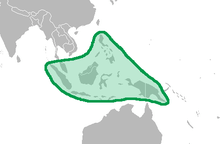Malesia

Malesia is a biogeographical region straddling the Equator and the boundaries of the Indomalaya ecozone and Australasia ecozone, and also a phytogeographical floristic region in the Paleotropical Kingdom.
Floristic province
Malesia was first identified as a floristic region that included the Malay Peninsula, the Malay archipelago, New Guinea, and the Bismarck Archipelago,[1] based on a shared tropical flora derived mostly from Asia but also with numerous elements of the Antarctic flora, including many species in the southern conifer families Podocarpaceae and Araucariaceae. The floristic region overlaps four distinct mammalian faunal regions.
Sundaland
The western part of Malesia, which includes the Malay Peninsula and the islands of Sumatra, Java, Bali, and Borneo, shares the large mammal fauna of Asia and is known as Sundaland. These islands are on Asia's relatively shallow continental shelf, and were linked to Asia during the ice ages, when sea levels were lower. The eastern edge of Sundaland is the Wallace line, named after Alfred Russel Wallace, the nineteenth-century British naturalist who noted the difference in fauna between islands on either side of the line. Dipterocarps are predominant trees in the lowland forests of Sundaland.[2]
Philippines
Most of the Philippines were never connected to the Asian mainland, and have a largely Asian-derived flora, and a distinct mammalian fauna.
Wallacea
The islands between Sundaland and New Guinea, called Wallacea, were never linked to the neighboring continents, and have a flora and fauna that include Indomalayan and Australasian elements.
New Guinea and the Bismarck Archipelago
The eastern end of Malesia, which includes New Guinea and the Aru Islands of eastern Indonesia, is linked to Australia by a shallow continental shelf, and shares many marsupial mammal and bird taxa with Australia. New Guinea also has many additional elements of the Antarctic flora, including southern beech (Nothofagus) and eucalypts. New Guinea has the highest mountains in Malesia, and vegetation ranges from tropical lowland forest to tundra.
See also
- Phytochorion - floristic regions and provinces
External links
 Media related to Indomalaya at Wikimedia Commons
Media related to Indomalaya at Wikimedia Commons Media related to Fauna of Malesia at Wikimedia Commons
Media related to Fauna of Malesia at Wikimedia Commons
References
- ↑ Wikramanayake, Eric; Eric Dinerstein; Colby J. Loucks; et al. (2002). Terrestrial Ecoregions of the Indo-Pacific: a Conservation Assessment. Island Press; Washington, DC. p 61
- ↑ Wikramanayake, Eric; Eric Dinerstein; Colby J. Loucks; et al. (2002). Terrestrial Ecoregions of the Indo-Pacific: a Conservation Assessment. Island Press; Washington, DC. p 61
| ||||||||||||||||||||||